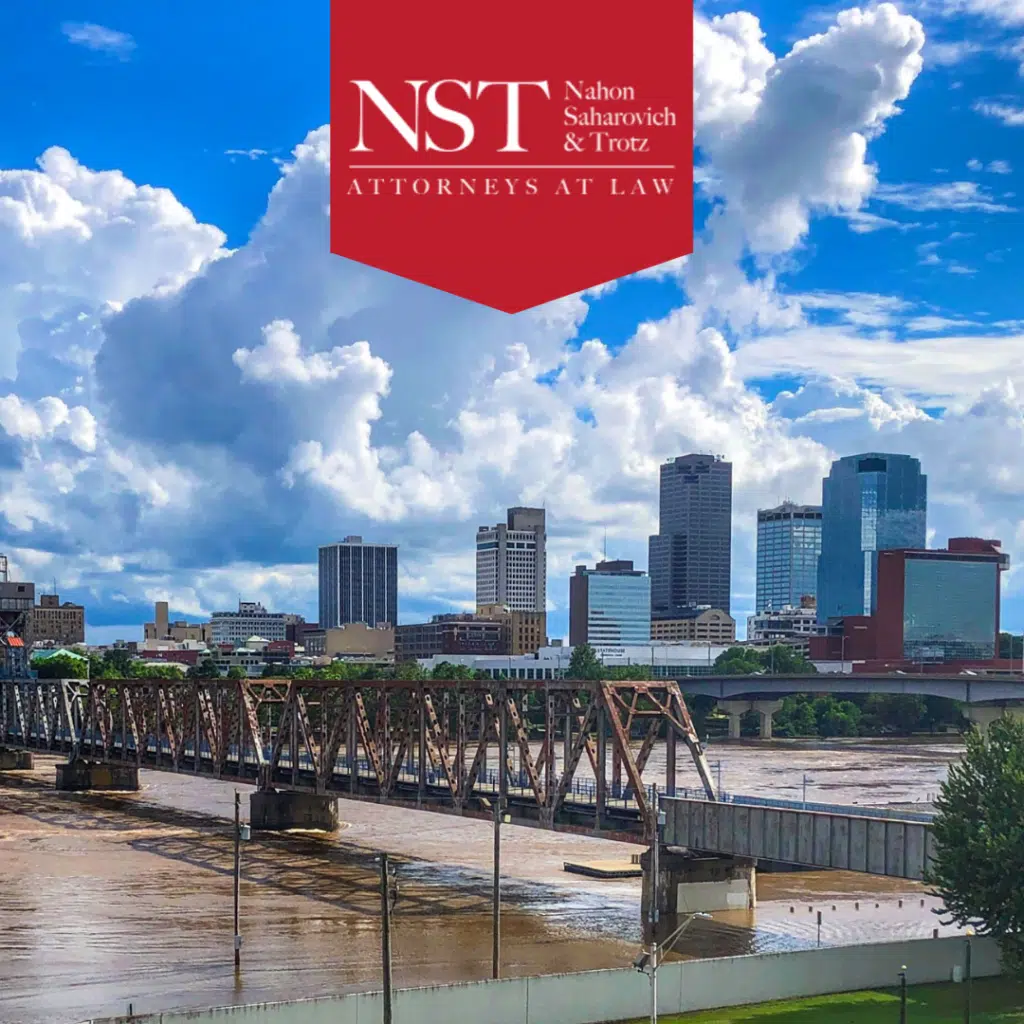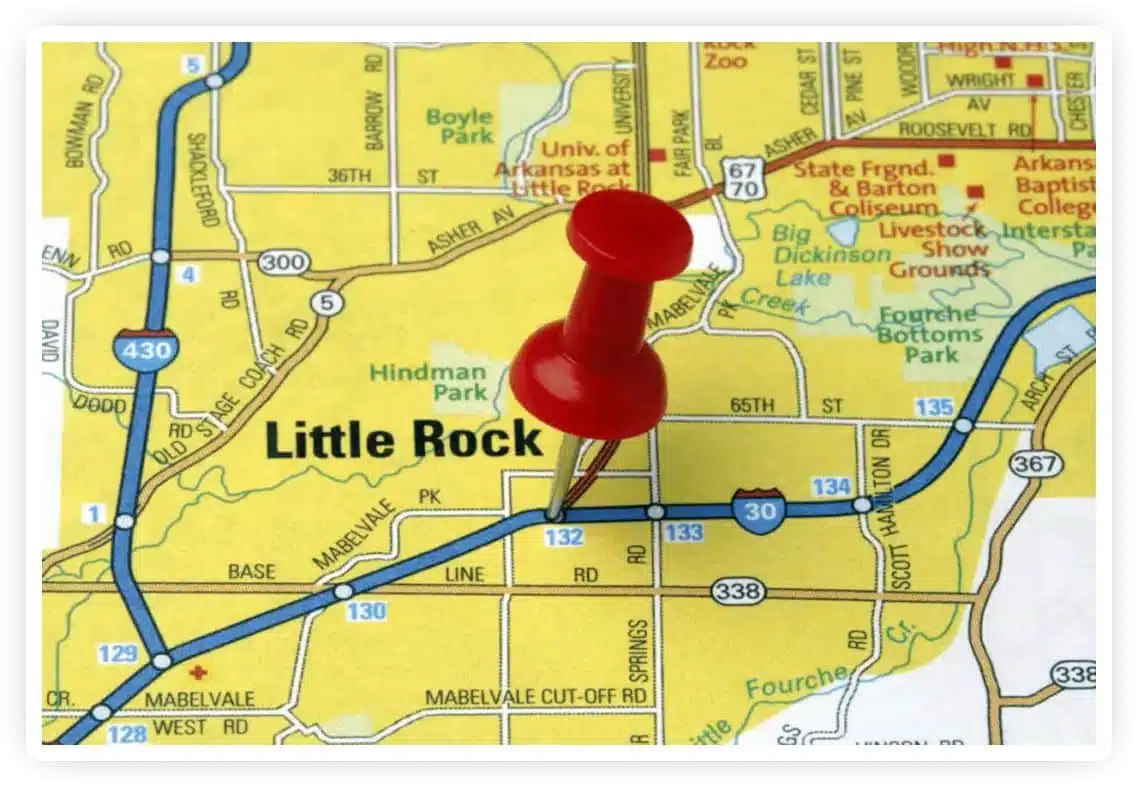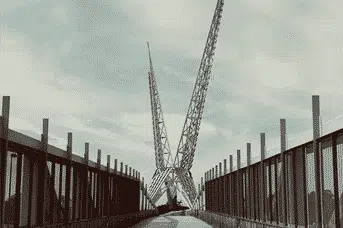Driving in
Little Rock
Little Rock, Arkansas, is one of the top destinations for tourists to visit in Arkansas. From the city’s Military History Tour to cyclists riding through the mix of natural and urban landscapes to diners eating on Little Rock’s iconic patios, there’s something for everyone to do in Little Rock. While the Clintons may have put Little Rock on the map, the historic capital has always offered many fun activities. These include exploring the Pinnacle Mountain State Park, wandering shops, learning at the incredible museums that show the stories of everything to the Children’s Museum, exploring the Museum of Discovery, or visiting animals at the Little Rock Zoo.
That leads to the question – what is the best way to get around Little Rock, Arkansas, and how can you navigate the roads while driving from one destination to the next?

MAJOR LITTLE ROCK HIGHWAYS AND ROADS
With the city being exactly halfway between Canada and Mexico, the region hosts 100 million people in a 550-mile radius. The interstates allow the area to act as a perfect intermodal network to all of the geographic and population centers in the United States. The major highways in Little Rock include:
This highway runs from North Carolina to California and is the longest major Interstate Highway that runs east to west throughout the United States.
This highway runs from Little Rock to Texas and Mexico, converging in the region.
Some of the smaller but well-known city highways include:
This interstate is 12.93 miles long and runs through Pulaski County, Arkansas, in the western part of the Little Rock beltway system. This interstate also links I-30 in the southwest region of the city with I-40 in North Little Rock.
Longer than the previous two, I-530 is 46.65 miles long, running north to south from Pine Bluff north-northwest to Little Rock, connecting I-30, I-440, US 65, US 67, and US 167. This highway also travels through Redfield and White Hall.
This interstate is 14.16 miles long, running through the central part of Arkansas to form a partial loop that connects US 67, US 167, and I-40 to I-30 and I-530.
This highway runs for 6.4 miles from east to west within Little Rock. I-630 is also known as the Wilbur D. Mills Freeway and begins at I-30, US Route 65, US 67, and US 167.
Though Little Rock was ranked as the #1 place to live in 2013, it’s not just a popular spot for people to settle down in. The city is also a top affordable place to travel to as well. It is known for its charming hospitality, rich history, and culture. Here are some of the top landmarks and places to visit:
The Little Rock Zoo
Founded in 1926, the Little Rock Zoo covers 33 acres and is home to more than 725 animals (of over 200 species). You can find the zoo in the heart of the city in War Memorial Park, just off of Fair Park Boulevard and Wilbur D. Mills Freeway.
Little Rock Central High School National Historic Site
This high school is still operating. However, it also hosts a museum at the site of pivotal desegregation events in 1957. In that year, this school was the center of and catalyst for change and a fundamental test for the United States. Visitors can learn about the deep histories of civil rights, human rights, and desegregation. You can find this historic landmark right off of W Daisy L. Gatson Bates Dr. and S Park St. across the street from the Central High Museum Inc. Commemorative Garden.
Big Dam Bridge
This incredible site was initially intended to be called the Murray Bridge. It spans the Arkansas River and Murray Lock and Dam. This bridge is only open to pedestrian and bicycle traffic. It is 90 feet above the Arkansas River. The bridge connects over 14 miles of scenic trails in both Little Rock and North Little Rock. You can find it right by Cook’s Landing Park and La Harpe View Park.
MacArthur Museum of Arkansas Military History
This museum resides in the Tower Building of the Little Rock Arsenal within the MacArthur Park Historic District. The museum includes artifacts, photographs, weapons, uniforms, and documents from those men and women who served in the military both at home and abroad. You can find this historic site at the intersection of I-30 and I-630, west of McMath Ave. and south of E. 9th St.
Bill Clark Wetlands
If you’re looking to get out and enjoy nature while in the city, the Bill Clark Wetlands hosts the restored 13 acres of wetlands along the Arkansas River, adjacent to the Clinton Presidential Library. These wetlands are designed to show the wildlife and river life to educate the millions of visitors to the Clinton Presidential Park and Library. It’s located on the south shore of the Arkansas River, just east of I-65/I-67/I-30.
William J. Clinton Presidential Library
This library is located within the Clinton Presidential Center and Park and includes the Clinton Foundation and the University of Arkansas Clinton School of Public Service. The Library contains archival collections, research facilities, exhibits, and hosts educational programs and special events. This museum includes Oval Office and Cabinet Room replicas, showcasing documents, photographs, videos, and interactive stations. Located just southeast of the wetlands described above, you can find this library east of I-30, north of E 3rd St.
River Market District
The River Market District is the livelihood of downtown Little Rock. Known for its international food hall, a farmer’s market twice a week, and frequent concerts, the area is fun for visitors of all ages. You can find this lively district just west of Route 141A, south of the Arkansas River.
Old State House Museum
This historic site is the oldest surviving state capital building west of the Mississippi River. It was formerly known as the Old State House and opened in 1842. You can find this near the Arkansas River Trail, just east of Highway 708.
Other incredible sites to visit in the city include:
Vogel Schwartz Sculpture Garden
After visiting the Old State House Museum, you can head just a few feet east to the beautiful landscape architecture of outdoor “rooms” containing more than 90 works of art by sculptors from Arkansas and throughout the US. The Vogel Schwartz Sculpture Garden is perfect for finding city-focused art and beauty.
Testament: The Little Rock Nine Monument
This moving memorial site at the state capitol honors the incredible courage of the nine African-American students who integrated into the Little Rock Central High School in 1957. It sits on the northern side of the building facing the governor’s office window. It is the first civil rights monument in the South that is located on state capitol grounds.
Clinton Homes
Located at 5419 L St., young Bill and Hillary Clinton bought the one-story buff brick home, which visitors can still visit today. They lived here when the former president served as Arkansas Attorney General between 1977-1979. The Clintons then moved to a two-story frame home located at 816 Midland Street with their newborn daughter Chelsea Clinton after his loss to Republican Frank D. White.
GETTING AROUND LITTLE ROCK AND PUBLIC TRANSPORTATION
Little Rock sits at the center of the country, making getting to and from the city easy and traveling within the city even more accessible! Below we describe some of the easiest ways to get around the city:
Driving
If you’re driving across the country or renting a car to get around Little Rock, you’ll be able to navigate all of the roads as soon as you get to the city by taking Interstate 40, as US I-40 and US I-30 both run right through the city. Each of the highways we described above can get you north, south, east, and west all around the city. Once you have your destination within Little Rock in mind, jump in the car and go!
Public Transit
Residents, tourists, and other visitors can all hop on the Rock Region Metro, easily accessible to senior citizens and those with disabilities as well. This public transportation provides people with daily bus services through the entire central Arkansas area.
Metro Streetcar
This streetcar system runs for 3.4 miles and connects the city and North Little Rock. Over 100,000 people annually ride the Metro Streetcar, and many boast that it is a fun and unique way to see the downtown sights of central Arkansas’s twin cities. You’ll get to see breathtaking views of the Arkansas River while also enjoying a quick and easy way to get to many of the landmarks we have described in this article.
THE MOST DANGEROUS ROADS AND INTERSECTIONS IN LITTLE ROCK
As in any city, drivers in Little Rock must be aware of the major intersections where accidents commonly occur. Arkansas is one of the most dangerous states to drive around in the United States, as there is a higher-than-average number of car accidents in the state each year. Since, based on its location, drivers drive through Arkansas at a higher rate than most other states, a larger number of accidents is inevitable.
In Little Rock, the city streets have higher populations and can also be prone to accidents involving cars, bicyclists, and pedestrians—many of which can result in serious injury. Specifically, downtown Little Rock’s business and most dangerous areas fall along where I-30 meets US Highway 70 and where US Highway 70B meets State Road 5. One of the most dangerous intersections is the intersection at Asher Avenue and University Avenue, right by the Consulate of Mexico in Little Rock, and near Big Lots and popular restaurants, such as the Waffle House, China Plus Buffet, and Long John Silver’s.

TRAFFIC UPDATES
People traveling within the city can always stay up-to-date with traffic updates by checking out IDriveArkansas.com on the web or mobile app. This site provides real-time updates on traffic conditions in the area and other traveler information reports. When you access the app, you can provide your own updates to report litter or report other problems as you encounter them.
You can also call or text the Arkansas Department of Transportation for traveler information at 501-569-2374.
If there is an accident, the accident will be updated through these resources, as traffic is likely to be worse in those areas. If you are in an accident, it is crucial to ensure that you and the other people involved in the crash are okay. Then, you should contact the police to report the accident and exchange information with the other people involved.
COSTS OF TRAFFIC TICKETS
Speeding is never a good idea, as it can cause accidents, injuries, and even wrongful death. Arkansas’s speeding laws can also lead to hefty penalties. Arkansas law is divided into two parts:
Basic Speeding Law
These laws prohibit a driver from driving at a speed that is “greater than is reasonable and prudent” under the existing conditions at the time of driving. These laws also require drivers to proceed at a speed so that the driver can avoid collisions. The speed limits vary based on conditions. For example, if it is a sunny day, 55 miles per hour (mph) may be considered safe, while if it is rainy and dark, 55 mph would likely be regarded as dangerous and a violation of the basic speeding law.
Absolute Speed Limits
These laws prohibit drivers from driving at a specific speed in specific areas. Unless otherwise posted on a sign, the absolute speed limits are:
25 mph in school zones
35 mph in urban districts
55 mph for large trucks on other roadways
65 mph for cars and light trucks on other roadways
If you violate any of the speeding laws, the penalties will likely depend on the circumstances and exact laws you violated. Generally, the penalties are:
First Violation
For the first speeding violation within a year, drivers could face up to $100 in fines and/or a potential maximum of ten days in jail.
Second Violation
For the second speeding violation within a year, drivers could face up to $200 in fines and/or a potential maximum of 20 days in jail.
Third Violation
For the third speeding violation within a year, drivers could face up to $500 in fines and/or a potential maximum of six months in jail.
Exceeding speed limits by more than 15 mph
If a driver is caught going over the speed limit by more than 15 mph, they can be charged with a Class C misdemeanor. If convicted, these drivers could face up to $500 in fines and a maximum of 30 days in jail.
Speeding violations will also result in at least three points added to the driver’s record. If a driver accumulates too many points, their license may be suspended. Also, depending on the circumstances, a person could be found to be a reckless driver, leading to a “reckless driving” conviction. In this case, the person could face a Class B misdemeanor charge, leading to a maximum of $500 in fines and/or potentially 90 days in jail.
GETTING TO OTHER MAJOR CITIES
As Little Rock is quite literally in the center of the country, there are many different ways you can get to and from the city from around the nation.
A railroad is a fun option. If you’re trying to find a way to get to or from Little Rock easily, Amtrak’s Texas Eagle is an excellent option for those coming in from Chicago, St. Louis, Dallas, Fort Worth, or many other cities around the country! This Amtrak allows travelers to arrive relaxed and ready to explore. You can enjoy dinner in a dining car on the train or can watch a movie in the lounge.
Air travel is also convenient. The Bill and Hillary Clinton National Airport (LIT) is the largest commercial service airport in Arkansas. You can travel to and from 334 unique destinations outside of Little Rock with only one stop from LIT. The airport hosts six airlines that offer more than 50 daily flights from Arkansas to the country’s major hubs. You can also catch non-stop flights to and from Destin-Fort Walton Beach, New Orleans, Houston, Las Vegas, Dallas, Atlanta, Orlando-Sanford, Detroit, Denver, Chicago, St. Louis, Charlotte, and Phoenix.
Driving is another option. Some cities are close enough to drive to and from Little Rock, while others can make a road trip out of the drive. Here are some of the common cities to travel to and from Little Rock and their respective distances from Little Rock:







LITTLE ROCK DRIVING LAWS
When driving in Little Rock, it is critical to know about both state and local laws to ensure you do not get fined or violate any driving laws.
On both a state and local level, the laws prohibit drivers from using their phones while driving. This includes sending text messages or using your phone in any way that may cause distracted driving. Drivers can use hands-free cell phones if they are over the age of 18. Further, no one can use handheld cell phones in active school zones or highway work zones. The only exception is in the case of an emergency.
Arkansas law does not reference “lane splitting” and does not require turn signals. Further, Arkansas does not require adults over 21 years old to wear a motorcycle helmet. Other drivers must be aware of motorcycles while driving to prevent motorcycle accidents.
Drivers from other countries can drive in Arkansas only if they have a valid, unexpired international driver’s license. However, if you plan to be in Arkansas for longer than six months, law enforcement recommends getting an Arkansas driver’s license.
You can get a driver’s permit at 14 years old but cannot get a driver’s license until you turn 16 years old.
Arkansas recently passed a bill that will allow self-driving car companies to test fully autonomous vehicles on state roads.
While pedestrians certainly have the right not to be hit by a vehicle, pedestrians are required to yield the right-of-way to all vehicles on a roadway at any point outside of a marked crosswalk.
HOW TO GET A DRIVER’S LICENSE IN LITTLE ROCK
You can obtain a driver’s license in Little Rock from a local revenue office. Visitors with international driver’s licenses have 30 days to get their Arkansas driver’s license. To obtain your license, you will have to:
- Pass the written test. The written test assesses the driver’s theoretical knowledge of the traffic laws in the US and Arkansas.
- Pass the driving test. The driver must take the driving test, which tests the actual driving skills and can be used throughout the US.
To apply for a driver’s license, you will have to show proof that you have a legal presence in the US.
PARKING IN LITTLE ROCK
If you are traveling to Downtown Little Rock, you can find ample parking at the Little Rock Convention & Visitors Bureau. Other parking areas include the Robinson Center Parking Garage at Markham and Spring Streets, the Convention District Parking Deck at 2nd and Main Streets, the River Market Parking Deck at River Market Avenue & 2nd Street, and a parking lot located across the street from the Statehouse Convention Center on the corner of Markham and Scott Streets.
There are also multiple surface parking lots and on-street parking in the downtown area. If you have trouble parking, you can also download ParkMobile, a free app available to help you find parking!
OTHER ASPECTS THAT AFFECT DRIVING
When driving in Little Rock, always be careful when driving in the winter. Arkansas is the 5th highest-ranked state in terms of the most dangerous states to drive in as of 2020. This can be attributed to distracted driving, such as cellphone use, and the harsh winter weather that causes roads to get icy and even more dangerous. These conditions can also contribute to serious truck accidents, which tend to have more severe consequences due to the size and weight of commercial vehicles.
 Skip to content
Skip to content
